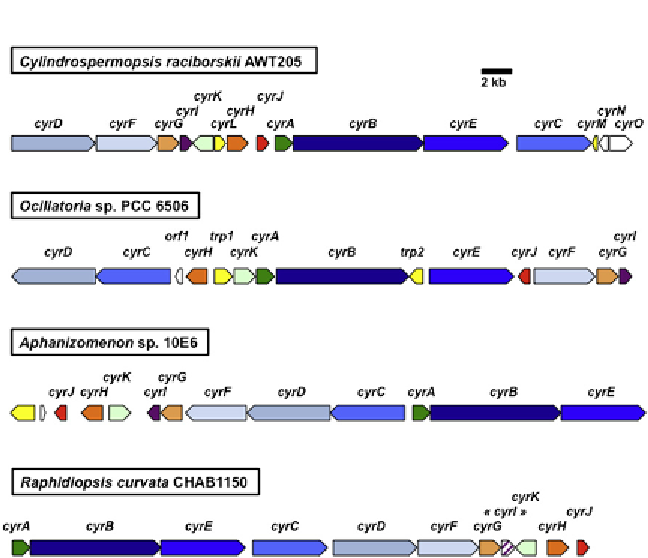Biology Reference
In-Depth Information
Figure 6.8
Thefour
cyr
clusterssofaridentiied.Thetransposasegenesarecolouredin
yellow.The
cyrN
and
cyrM
genesin
Cylindrospermopsis raciborskii
werenotfoundinthe
other
cyr
clusters.In
Raphidiopsis curvata
,
cyrI
isapseudogene,andthisstrainproduces
7-deoxycylindrospermopsin.Seethecolourplate.
The regulation of the production of cylindrospermopsin at the tran-
scriptional level as well at the metabolic level has been studied by Kaplan
and co-workers (
Shalev-Malul et al., 2008
). They identified an Abr-B-like
protein that specifically binds to the promoter region between
cyrA
and
cyrC
genes. They also reported that light and nitrogen availability affected the
transcription of these genes as well as the cylindrospermopsin production.
The biosynthesis of cylindrospermopsin has been proposed on the basis
of feeding experiments and bioinformatics analysis of the biosynthetic
genes (
Fig. 6.9
). It starts with the formation of guanidinoacetate catalysed
by the amidinotransferase, CyrA, that has been studied in vitro as an isolated
enzyme (
Muenchhoff, Siddiqui, & Neilan, 2012
;
Muenchhoff et al., 2010
).
Then, guanidinoactetate is thought to be loaded on the PKS CyrB for
extension. Four further PKSs (CyrB, C, D and E) are thought to extend the
chain that will finally lead to the desulfated 7-deoxycylindrospermopsin.

